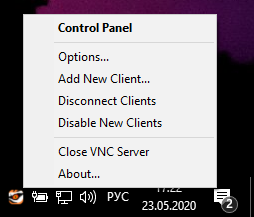

Other valid forms are param = value - param= value - param= value. Parameters which take a value can be specified as - param value. Parameters can be turned on with - param or off with - param=0. You can get a list of parameters by giving -h as a command-line option to vncviewer. If the remote screen is bigger, you can scroll by bumping the mouse against the edge of the screen. This is particularly useful when connecting to a remote screen which is the same size as your local one. Full-Screen ModeĪ full-screen mode is supported.
So to get an F8 through to the VNC server simply press it twice.
TIGERVNC VIEWER WINDOWS PASSWORD
If the password is correct, a window will appear showing the desktop of the VNC server. You can also add 'VNC_USERNAME' and 'VNC_PASSWORD' to environment variables. If the VNC server is successfully contacted, you will be prompted for a password to authenticate you. Additional options may be given too, but the given configuration file will overwrite any conflicting parameters.

The file name needs to include a path separator. Where './some.tigervnc' is an existing and valid TigerVNC configuration file. Alternatively, specify the VNC server as an argument, e.g.: If you run the viewer with no arguments it will prompt you for a VNC server to connect to.
TIGERVNC VIEWER WINDOWS MANUAL
This manual page documents version 4 for the X window system. Vncviewer is a viewer (client) for Virtual Network Computing. Launch a VNC client which connects to a host on a given port: vncviewer host:: port.Launch a VNC client with a specific screen geometry: vncviewer -geometry widthx height host: display_number.Launch in full-screen mode: vncviewer -FullScreen host: display_number.Launch a VNC client which connects to a host on a given display: vncviewer host: display_number.


 0 kommentar(er)
0 kommentar(er)
